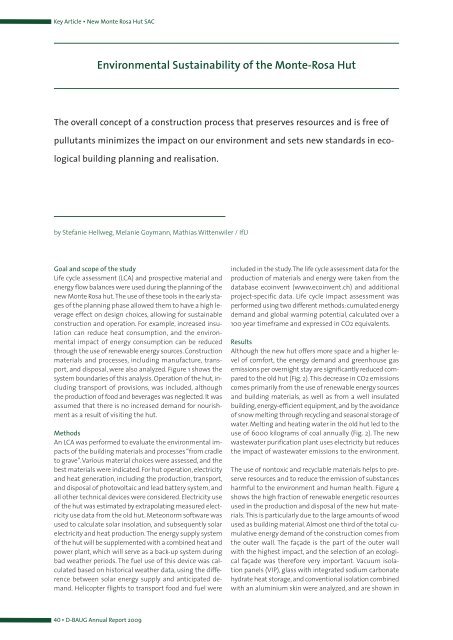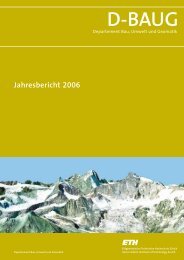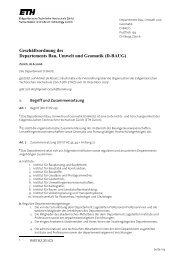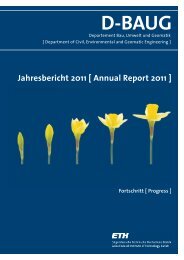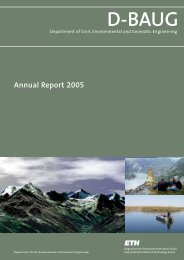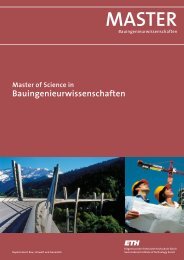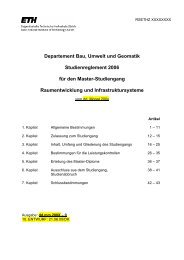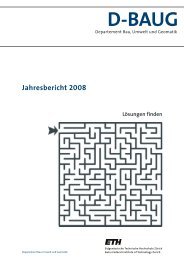D-BAUG - Departement Bau, Umwelt und Geomatik - ETH Zürich
D-BAUG - Departement Bau, Umwelt und Geomatik - ETH Zürich
D-BAUG - Departement Bau, Umwelt und Geomatik - ETH Zürich
Create successful ePaper yourself
Turn your PDF publications into a flip-book with our unique Google optimized e-Paper software.
Key Article ▪ New Monte Rosa Hut SAC<br />
Environmental Sustainability of the Monte-Rosa Hut<br />
The overall concept of a construction process that preserves resources and is free of<br />
pullutants minimizes the impact on our environment and sets new standards in eco-<br />
logical building planning and realisation.<br />
by Stefanie Hellweg, Melanie Goymann, Mathias Wittenwiler / IfU<br />
Goal and scope of the study<br />
Life cycle assessment (LCA) and prospective material and<br />
energy flow balances were used during the planning of the<br />
new Monte Rosa hut.The use of these tools in the early stages<br />
of the planning phase allowed them to have a high leverage<br />
effect on design choices, allowing for sustainable<br />
construction and operation. For example, increased insulation<br />
can reduce heat consumption, and the environmental<br />
impact of energy consumption can be reduced<br />
through the use of renewable energy sources. Construction<br />
materials and processes, including manufacture, transport,<br />
and disposal, were also analyzed. Figure 1 shows the<br />
system bo<strong>und</strong>aries of this analysis. Operation of the hut, including<br />
transport of provisions, was included, although<br />
the production of food and beverages was neglected. It was<br />
assumed that there is no increased demand for nourishment<br />
as a result of visiting the hut.<br />
Methods<br />
An LCA was performed to evaluate the environmental impacts<br />
of the building materials and processes “from cradle<br />
to grave”. Various material choices were assessed, and the<br />
best materials were indicated. For hut operation, electricity<br />
and heat generation, including the production, transport,<br />
and disposal of photovoltaic and lead battery system, and<br />
all other technical devices were considered. Electricity use<br />
of the hut was estimated by extrapolating measured electricity<br />
use data from the old hut. Meteonorm software was<br />
used to calculate solar insolation, and subsequently solar<br />
electricity and heat production. The energy supply system<br />
of the hut will be supplemented with a combined heat and<br />
power plant, which will serve as a back-up system during<br />
bad weather periods. The fuel use of this device was calculated<br />
based on historical weather data, using the difference<br />
between solar energy supply and anticipated demand.<br />
Helicopter flights to transport food and fuel were<br />
40 ▪ D-<strong>BAUG</strong> Annual Report 2009<br />
included in the study.The life cycle assessment data for the<br />
production of materials and energy were taken from the<br />
database ecoinvent (www.ecoinvent.ch) and additional<br />
project-specific data. Life cycle impact assessment was<br />
performed using two different methods: cumulated energy<br />
demand and global warming potential, calculated over a<br />
100 year timeframe and expressed in CO2 equivalents.<br />
Results<br />
Although the new hut offers more space and a higher level<br />
of comfort, the energy demand and greenhouse gas<br />
emissions per overnight stay are significantly reduced compared<br />
to the old hut (Fig. 2).This decrease in CO2 emissions<br />
comes primarily from the use of renewable energy sources<br />
and building materials, as well as from a well insulated<br />
building, energy-efficient equipment, and by the avoidance<br />
of snow melting through recycling and seasonal storage of<br />
water. Melting and heating water in the old hut led to the<br />
use of 6000 kilograms of coal annually (Fig. 2). The new<br />
wastewater purification plant uses electricity but reduces<br />
the impact of wastewater emissions to the environment.<br />
The use of nontoxic and recyclable materials helps to preserve<br />
resources and to reduce the emission of substances<br />
harmful to the environment and human health. Figure 4<br />
shows the high fraction of renewable energetic resources<br />
used in the production and disposal of the new hut materials.<br />
This is particularly due to the large amounts of wood<br />
used as building material. Almost one third of the total cumulative<br />
energy demand of the construction comes from<br />
the outer wall. The façade is the part of the outer wall<br />
with the highest impact, and the selection of an ecological<br />
façade was therefore very important. Vacuum isolation<br />
panels (VIP), glass with integrated sodium carbonate<br />
hydrate heat storage, and conventional isolation combined<br />
with an aluminium skin were analyzed, and are shown in


